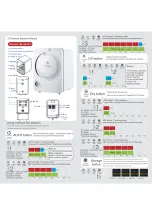
(continued)
Calibration
Recommended frequency
RNase P instrument
verification
• After installing or moving the instrument.
• After performing any of the calibrations.
• As needed to confirm instrument performance.
Note:
To prepare custom dye plates and to perform custom calibrations, see “Calibrate custom dyes”
Calibration descriptions
The combination of the instrument and the block is calibrated (see “Instrument and block calibration”
).
Calibration description and purpose
Pass criteria
ROI/Uniformity
• The software captures images for each optical filter.
• The software uses calibration data to map the increase in fluorescence
to the plate wells during subsequent runs and to evaluate well
‑
to
‑
well
consistency of the signals.
The image for each filter
distinguishes all wells of the plate.
Each well in the image is distinct.
Background
• The software captures background images for each optical filter in the
absence of sample and reagent, and it checks that the fluorescence
from each well is below a fluorescence threshold.
• The software uses calibration data to remove background fluorescence
during a run.
Note:
You can also run this calibration to determine if contamination is
related to the sample block or the plate.
The plate images for all filters are free
of abnormal fluorescence.
Dye
• The software extracts a spectral profile for each dye standard, then
produces a set of spectral profiles plotted as fluorescence vs filter.
• The software uses calibration data to characterize and distinguish the
individual contribution of each dye in the total fluorescence signals
collected by the instrument.
Dye spectra peak within the same
filter as their group.
Chapter 7
Calibrate and verify instrument performance
Calibration descriptions
7
86
QuantStudio
™
6 Pro Real-Time PCR System and QuantStudio
™
7 Pro Real-Time PCR System User Guide
















































